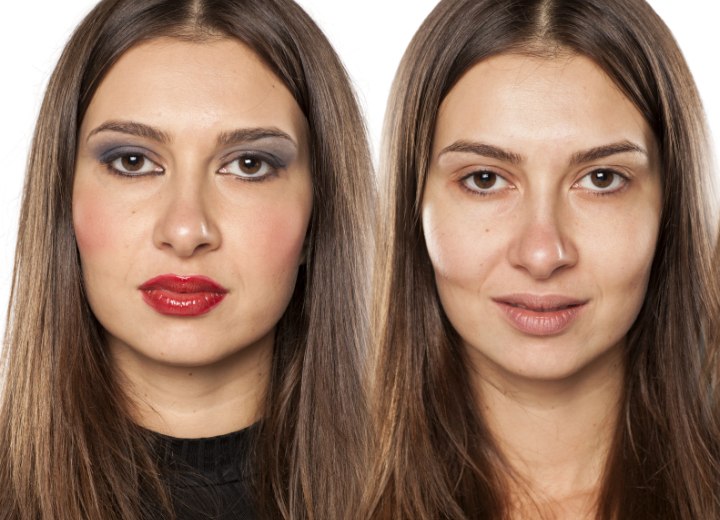Large Pores & Blemish-Prone Skin

Pores perform an essential function for your skin’s health by providing oil to keep skin soft and hydrated. However, you don’t necessarily want to be reminded of their existence every time you look in the mirror. Pores can become more prominent when they are dilated, infected, or clogged with oil, making them appear larger than they really are.
Everyone is different, and the size and appearance of the pores in the skin are just another way in which individuality asserts itself. While it isn’t possible to permanently “shrink” large pores, there are a number of ways to make them less noticeable.
There are two main factors that contribute to large pores: genetics and age. People who have skin that is naturally thick and oily tend to have larger pores. As people get older, too, sun damage and decreased skin elasticity can cause pores to dilate. The skin thickens, causing tiny cells to collect around the edge of the pores and make them look larger.
Blackheads are also a big contributor to large pores. When the pore becomes clogged by dirt and bacteria, oil within the pore begins to accumulate, causing the pore’s diameter to expand.
Shrinking Large Pores
Unfortunately, there is no way to permanently shrink large pores. The good news is that the appearance of large pores can be greatly reduced in a number of ways. For example, cleansing the pores of debris, excess oil, and bacteria will significantly reduce their prominence. This can be achieved by using a low-strength topical medication or face wash containing retinol or vitamin C. These antioxidants help the skin increase collagen and elastin production while simultaneously loosening dirt and oil from the pores.
Exfoliation can help in minimizing the appearance of large pores. This can be accomplished using an at-home facial scrub or by visiting a spa or dermatologist for a microdermabrasion treatment. Microdermabrasion is a special type of facial that gently scrubs off the dead surface lawyer of the skin, revealing softer, healthier skin beneath.
Makeup Tips – Reduce the Appearance of Large Pores
Never underestimate the power of cosmetics to minimize even the most prominent of facial flaws. Try reducing the appearance of large pores by using the following technique:
Start with a pre-foundation skin primer (a moisture-rich cream or tinted moisturizer) which will help even out your skin tone and keep foundation from soaking into your pores. Let the primer dry, and then apply your foundation using a makeup sponge. Use a cream or cream-to-powder foundation, which is more likely to conceal large pores than liquid foundation.
Finally, dust your face with a loose translucent powder. Large pores will be less visible, and your skin tone will appear more even.
Aging and Large Pores
Although large pores may be bothersome early in life, they can actually present some benefits as the skin begins to age. People with large pores tend to have oily skin, which can help counteract the drying and wrinkling of the skin that occurs with age. Although conscientious skin care is important for people of all ages and skin types, those with large pores can embrace the fact that their skin will likely retain its natural moisture well into their later years.
Blemish Prone Skin
“Blemish-prone skin” is probably the easiest of all the skin types to identify. It is usually skin that is a heavy oil producer and becomes inflamed and clogged from everyday environmental factors. For years, individuals with blemish-prone skin were labeled as lazy about skin care and hygiene, when the truth is that some people simply are more likely to develop breakouts and have problem skin. Here are some ways for treating blemish prone skin:
Cleansing
Wash with gel or liquid cleanser or any oil-preventing cleansing bar at least twice a day. Stripping the skin won’t help it, so opt in favor of gentler facial cleanser creams over stronger soaps. Hardened oil trapped in pores, not surface grease cause breakouts. Try “pre-treating” the skin before cleansing by using a hot towel as a compress on the skin for a few minutes (3-5) before washing with your favorite cleanser. If the skin doesn’t seem to be cleaned enough by this or is extremely oily, try using a medicated soap or cleanser formulated with triclosan, salicylic acid or benzoyil peroxide.
Toning
You can follow gel, liquid or bar cleanser with astringent and/or use toner to clean up during the day. However keep in mind that toners plus drying cleansers or acne medications may add up to excessive dryness.
Moisturizing
Always use a light, oil-free moisturizer when you have oily skin. You want a moisturizer that will absorb quickly into the skin, and leave it feeling dewy rather than slick or greasy. Heavy cream lotions are more likely to clog the pores and therefore should be avoided.
Spot Control
These days acne medications not only help clear up breakouts, but can help to unclog pores to prevent future blemishes. Benzoyl peroxide can be drying to the skin, so start with a milder, 5% concentration, and then go to 10% if the skin needs and tolerates it. Salicylic acid is less drying to the skin so it can be used with stronger cleansers.
Avoid facial “scrubs” that have exfoliant ‘granules” as they can irritate blemishes if skin’s broken out. Clay masks sop up oil and remove surface cells, so feel free to add them to your routine once a week or so, but they’re no substitute for regular medication.
©Hairfinder.com
See also:
Moisturizers
Make-up How To